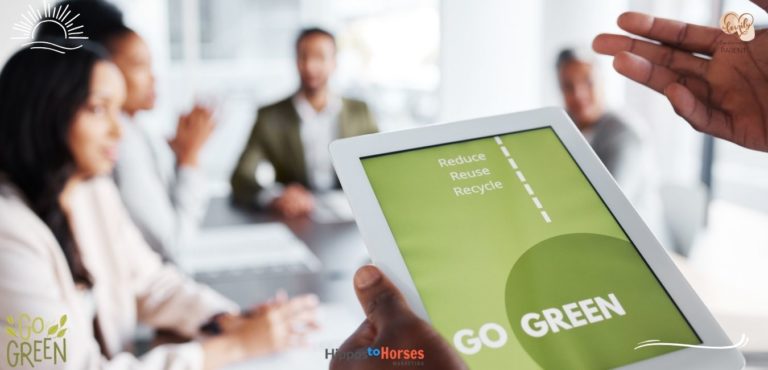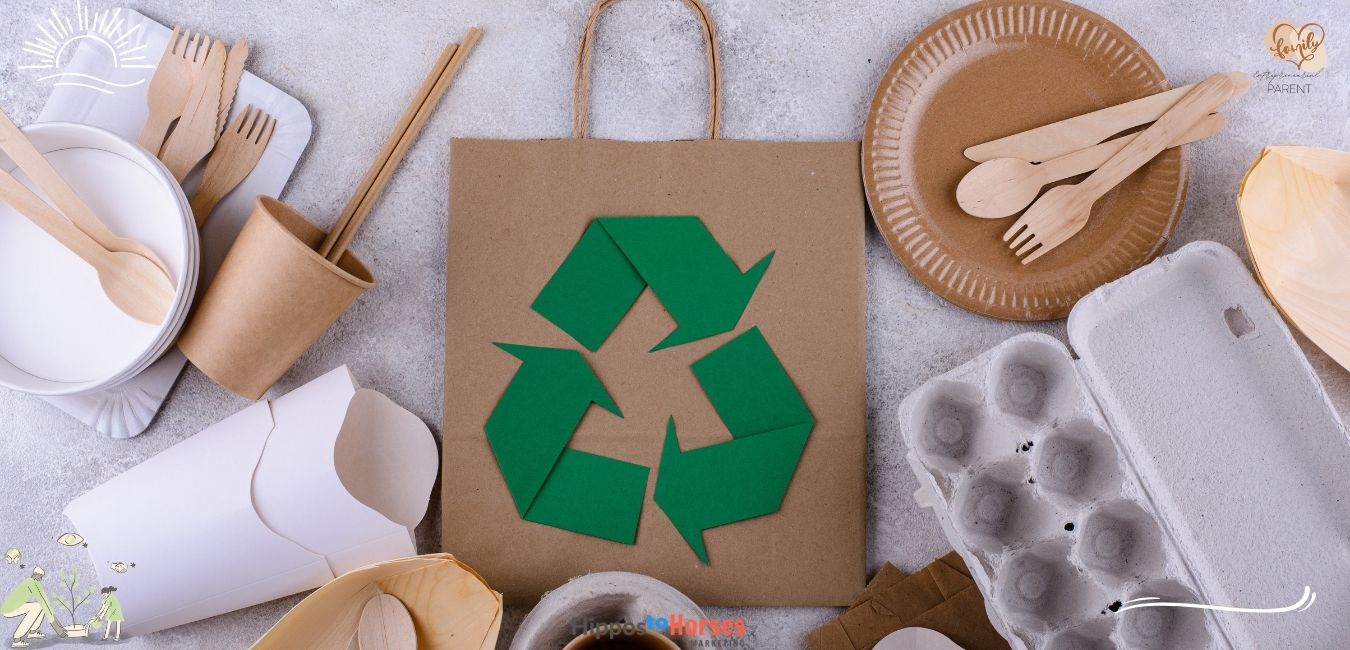Balancing Family and Business: A Guide to Sustainable Marketing for Stay-at-Home Entrepreneurs
As a stay-at-home parent and entrepreneur, you understand the importance of balancing your family life with your business aspirations. At Hippos to Horses Marketing, we believe that building a successful online business doesn’t have to come at the expense of our planet. Sustainable marketing is not just a trend; it’s a necessity for the future. In this blog, we’ll explore sustainable marketing, why it’s crucial, and how you can implement it in your business while maintaining the flexibility and freedom you need to be there for your family.
What is Sustainable Marketing?
Sustainable marketing is about promoting products and services in a way that respects and preserves the environment. It involves integrating eco-friendly practices into your marketing strategies and focusing on long-term benefits rather than short-term gains. This approach not only helps protect our planet but also builds trust and loyalty among consumers who are increasingly concerned about environmental issues.
Sustainable marketing can take many forms, including:
- Eco-friendly packaging: Using biodegradable or recyclable materials to reduce waste.
- Energy-efficient operations: Implementing practices that reduce energy consumption, such as using renewable energy sources or optimizing digital operations to lower carbon footprints.
- Ethical sourcing: Ensuring products are sourced from suppliers that adhere to fair trade and environmental standards.
By adopting these practices, you can create a business that thrives and contributes positively to the environment.

Why Sustainable Marketing Matters for Stay-at-Home Entrepreneurs
The importance of sustainable marketing cannot be overstated. As our global environmental challenges grow, businesses must take responsibility for their impact on the planet. Sustainable marketing helps reduce this impact by promoting eco-friendly products and practices. Moreover, it appeals to a growing demographic of conscious consumers who prefer to support businesses that align with their values.
Consumer Trends and Preferences
According to a 2022 report by Porter Novelli, 84% of people are concerned about the planet and are looking for ways to live more sustainably. By adopting sustainable marketing practices, you can attract these consumers, build a loyal customer base, and differentiate your business in a crowded market. Additionally, a Nielsen study found that 66% of global consumers are willing to pay more for sustainable brands, highlighting the commercial benefits of adopting eco-friendly practices.
Long-Term Business Benefits
Sustainable marketing can also lead to long-term business benefits, including:
- Brand loyalty: Customers are likelier to remain loyal to brands that share their values.
- Cost savings: Implementing energy-efficient practices and reducing waste can significantly save costs.
- Regulatory compliance: Staying ahead of environmental regulations can prevent potential fines and legal issues.
By focusing on sustainability, you are investing in the future of your business and the planet.
Greenwashing vs. Greenhushing: Navigating the Pitfalls
As you embark on your sustainable marketing journey, it’s crucial to navigate the potential pitfalls of greenwashing and greenhushing. Understanding these concepts will help you maintain authenticity and credibility with your audience.
Greenwashing: The Pitfalls of Deceptive Practices
Greenwashing refers to the practice of making false or misleading claims about a product or service’s environmental benefits. This can damage your reputation and erode trust with your customers. A notable example is Volkswagen’s emissions scandal, in which the company falsely claimed its cars were environmentally friendly. The backlash was severe, resulting in significant financial and reputational damage.
Another example is H&M, which faced criticism for its “Conscious Collection.” Despite marketing the line as sustainable, investigations revealed that many of the products were not as eco-friendly as claimed. This led to consumer backlash and a loss of trust.
Greenhushing: The Silence of Good Intentions
On the other hand, greenhushing involves under-communicating your sustainability efforts to avoid scrutiny and accusations of greenwashing. While this might seem safer, it means taking advantage of opportunities to engage with your audience and highlight your positive impact. Companies like Patagonia have successfully navigated this by being transparent and honest about their sustainability efforts, even when they fall short of perfection.
Patagonia is known for its commitment to environmental causes and open communication of its efforts. The company’s “Don’t Buy This Jacket” campaign encouraged customers to think twice before purchasing new products and highlighted the importance of reducing consumption. This honest and transparent approach has built a strong, loyal customer base and enhanced Patagonia’s reputation as a leader in sustainability.

Building a Sustainable Online Business as a Stay-at-Home Entrepreneur
As a stay-at-home entrepreneur, you have the unique opportunity to build a business that reflects your values and supports your lifestyle. Here are some steps to help you create a sustainable online business:
Nailing Down Your Niche
Identifying your niche is crucial for effective and sustainable marketing. Focus on a specific market segment that aligns with your values and expertise. This allows you to communicate more effectively with your target audience, build a loyal customer base, and stand out from competitors.
Consider these tips for finding your niche:
- Identify your passions: What are you passionate about? Aligning your business with your interests will make it more enjoyable and sustainable in the long run.
- Research market demand: Look for gaps in the market where your skills and interests meet consumer needs.
- Evaluate competition: Analyze your competitors to identify what sets you apart and how you can offer something unique.
Focusing on a niche that you are passionate about and that has market demand can help you create a business that is both fulfilling and profitable.
Email Marketing and Environmental Impact
Email marketing is a powerful tool for reaching your audience, but it’s essential to be mindful of its environmental impact. The sheer volume of emails sent daily contributes to energy consumption and carbon emissions. In 2023, it was estimated that over 300 billion emails were sent daily, with an average click-through rate of just 2.5%. To minimize your impact, focus on quality over quantity: send targeted, relevant emails that provide real value to your subscribers.
Here are some tips for sustainable email marketing for Stay-at-Home Entrepreneurs
- Segment your audience: Tailor your emails to specific segments of your audience to ensure relevance and increase engagement.
- Optimize email frequency: Avoid bombarding your subscribers with too many emails. Instead, focus on sending fewer, high-quality emails.
- Use clean design: Simplify your email designs to reduce data load and improve readability.
- Monitor performance: Regularly analyze your email metrics to understand what works and make necessary adjustments.
By adopting these practices, you can reduce the environmental impact of your email marketing campaigns while maintaining effectiveness.
Social Media: Balancing Reach and Responsibility
Social media is another essential marketing tool, but it, too, has an environmental footprint. The servers that host social media platforms consume significant amounts of energy. You can reduce this impact by being strategic with your social media use. Create meaningful, engaging content that resonates with your audience rather than constantly posting to stay visible.
Consider these strategies for sustainable social media marketing for Stay-at-Home Entrepreneurs
- Focus on quality content: Prioritize creating high-quality, valuable content over frequent posting. This will help you stand out and build a loyal following.
- Use scheduling tools: Plan and schedule your posts in advance to maintain a consistent presence without the need for constant online activity.
- Engage authentically: Foster genuine interactions with your audience by responding to comments and messages thoughtfully.
- Measure impact: Track the performance of your social media campaigns to understand what resonates with your audience and optimize your strategy.
By adopting these practices, you can maintain an effective social media presence while minimizing your environmental impact.

Sustainable Marketing Plans for Stay-at-Home Entrepreneurs
Creating a sustainable marketing plan involves thoughtful planning and execution. Digital activities have an environmental impact, and it’s important to consider minimising this. By adopting these practices, you can maintain an effective social media presence for your online business while reducing your environmental impact, all while enjoying time with your family. Here are some steps to help you develop a plan that aligns with your sustainability goals and fits seamlessly into your home-based online business routine:
1. Assess Your Current Practices
Start by evaluating your current marketing strategies and identifying areas where you can reduce your environmental impact. This might include:
- Optimising Digital Marketing Methods: Use energy-efficient devices, reduce data storage, and optimise your website for faster loading times to lower energy consumption.
- Reducing Print Materials: Limit the use of printed flyers or brochures. Instead, focus on digital content, which is eco-friendly and easier to manage from home.
- Eco-Friendly Packaging: For any products you sell, choose packaging made from sustainable materials and encourage your customers to recycle.
2. Set Clear Goals
Define what you want to achieve with your sustainable marketing efforts. Clear, measurable goals help guide your strategy and provide benchmarks for success. These goals might include:
- Reducing Waste: Aim to minimise the waste generated by your marketing activities, such as opting for digital rather than physical collateral.
- Using Eco-Friendly Materials: Commit to using materials with a lower environmental impact, whether in packaging, promotional items, or event supplies.
- Supporting Environmental Causes: Partner with environmental organisations, sponsor green initiatives or donate some of your profits to environmental causes.
3. Choose the Right Channels
Focus on marketing channels that align with your sustainability goals. Consider the environmental impact of each channel and prioritise those that offer the most significant benefits with the least harm:
- Efficient Digital Marketing: Utilise email campaigns, social media, and content marketing efficiently. Schedule posts, use cloud services that prioritise green energy, and reduce the carbon footprint of your digital activities.
- Sustainable Event Marketing: When hosting events, choose venues that prioritise sustainability, use digital invitations, and provide eco-friendly giveaways.
- Eco-Friendly Merchandise: If you offer promotional products, select items made from recycled materials, are biodegradable, or have a longer lifecycle to reduce waste.
4. Integrate Sustainability into Your Brand
Make sustainability a core part of your brand identity. This involves:
- Transparent Communication: Clearly communicate your sustainability initiatives and progress to your audience. Transparency builds trust and demonstrates your commitment to environmental responsibility.
- Education and Engagement: Educate your audience about the importance of sustainability and how they can contribute. Engaging content that informs and inspires can enhance your brand’s reputation and foster a loyal community.
- Consistent Practices:Ensure that all aspects of your marketing activities align with your sustainability goals, from the suppliers you choose to the partners you collaborate with to the product or service you provide.
5. Measure and Adjust
Regularly measure the impact of your sustainable marketing efforts to identify areas for improvement. Use metrics such as:
- Carbon Footprint: Monitor the energy consumption of your digital activities to track the reduction in your marketing-related carbon emissions.
- Waste Reduction: Monitor the decrease in physical waste generated by your marketing activities.
- Customer Feedback: Collect feedback from your audience regarding your sustainability initiatives to gauge their effectiveness and areas for enhancement.
By incorporating these strategies into your marketing plan, you contribute to environmental preservation and build a brand that resonates with eco-conscious consumers. This dual benefit of sustainable practices—reducing environmental impact while strengthening brand loyalty—can set your business apart in an increasingly eco-aware market.
By adopting these practices, you can maintain an effective social media presence for your online business while minimising your environmental impact, all while enjoying time with your family.
Examples of Successful Sustainable Marketing
Learning from successful examples can inspire and guide your sustainable marketing efforts. Here are a few companies that have made significant strides in sustainable marketing:
Patagonia: Known for its commitment to environmental causes, Patagonia has built a strong reputation for sustainability. The company’s “Don’t Buy This Jacket” campaign encouraged consumers to think twice before making a purchase, highlighting the importance of reducing consumption and promoting environmental awareness.
Tesla: Tesla’s marketing strategy focuses on promoting its electric vehicles as a sustainable alternative to traditional gasoline-powered cars. By emphasizing the environmental benefits of their products, Tesla has attracted a loyal customer base and positioned itself as a leader in the green technology space.
Seventh Generation: This eco-friendly household products company has built its brand around sustainability. Seventh Generation uses plant-based ingredients and recyclable packaging, communicating its environmental commitment clearly and transparently to consumers.

Conclusion: Take Action for a Sustainable Future as a for Stay-at-Home Entrepreneurs
Sustainable marketing is not just good for the planet; it’s good for your business. As a stay-at-home entrepreneur, you have the power to build a business that aligns with your values and supports your lifestyle. By focusing on sustainable marketing practices, you can attract conscious consumers, build brand loyalty, and contribute to a healthier planet.
At Hippos to Horses Marketing, we encourage you to take the first step towards sustainable marketing today. Assess your current practices, set clear goals, and choose the right channels to reach your audience. Engage your customers with authentic, transparent communication, and continuously measure and adjust your efforts to ensure you’re making a positive impact.
Ready to make a difference? Sign up for our monthly newsletter. Let’s build a better future together, one sustainable business at a time.

